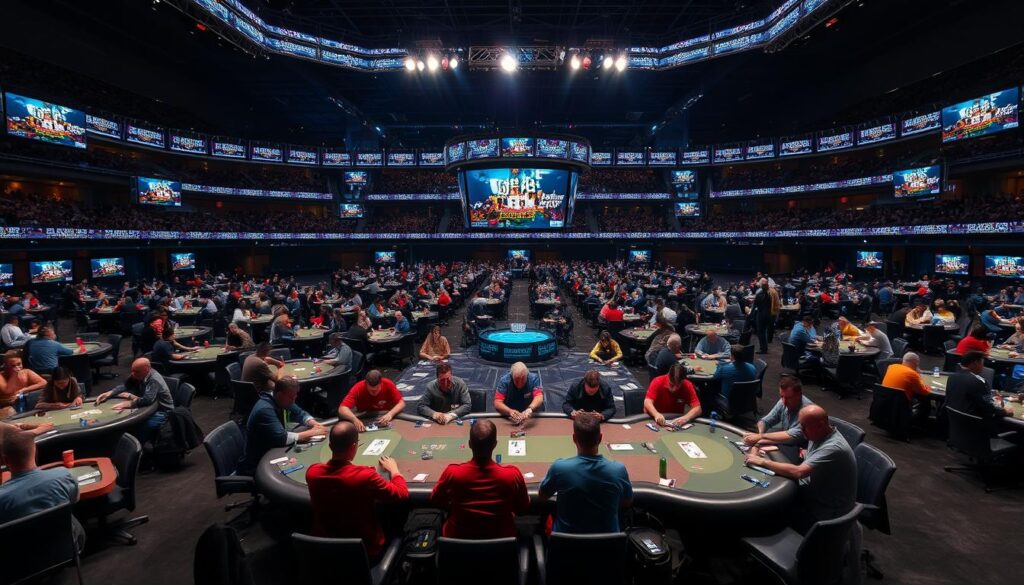Managing your bankroll is key to winning in poker tournaments. We’re here to share expert tips to boost your winnings. With a good bankroll plan, you can afford to play and win big.
Dewakoin knows a solid bankroll strategy is vital for success. We aim to give you a safe, fun, and rewarding online gaming experience. We offer the latest games with great winning chances.
Our expert advice can up your winning chances and cut down losses. We’ll share the latest on bankroll management. This includes tips on bankrolls for different games to help you succeed.
Key Takeaways
- Bankroll management is crucial for poker tournament success
- A well-planned bankroll management strategy can help you maximize your winnings and minimize losses
- Recommended bankrolls vary depending on the limit and game, but a general rule of thumb is to have at least 20 buy-ins
- Restricting your buy-ins to 2% of your bankroll can help you manage risk and avoid significant losses
- Expectation management is crucial, and turning $10 into $11 represents a 10% increase in poker tournament winnings
- Auto top-up features in cash games can lead to overspending, even for new players with smaller bankrolls
- Bankroll requirements per limit vary, but a suggested bankroll for new players is 50 buy-ins, even at NL2
Understanding the Fundamentals of Poker Tournament Bankroll Management
Managing your bankroll is key to winning in tournament poker. A good bankroll lets you play well without fear of losing all your money. It’s about knowing how much to invest in each game.
In tournament poker, you need more money than in cash games because of the game’s ups and downs. You should have enough money to handle the game’s swings. This way, you can keep playing without risking too much.
Here are some important tips for managing your bankroll in tournament poker:
- Have a bankroll that can cover at least 100 buy-ins to minimize the risk of going broke.
- Manage your buy-ins wisely, taking into account the variance of the game and your individual risk tolerance.
- Consider reinvesting a portion of your winnings back into your bankroll to support growth and maintain a healthy bankroll.
By following these bankroll management tips and staying disciplined, you can do better in tournament poker. You’ll have a more enjoyable and sustainable gaming experience.
Setting Realistic Tournament Buy-in Levels
Managing your bankroll is key to winning in poker tournaments. Think about your skill level, bankroll size, and how much risk you can take. For online Multi-Table Tournaments (MTTs), aim for at least 100 buy-ins because of the high variance. Live tournaments are softer, so 30-50 buy-ins are a good range.
It’s important to keep your poker bankroll separate from your personal money. This helps avoid losing everything. Tracking each poker session helps you see how well you’re doing. It guides your poker strategy and risk management.
Here are some general guidelines for tournament buy-in levels:
- Online MTTs: 100 buy-ins
- Live tournaments: 30-50 buy-ins
- Heads-up players: a few dozen buy-ins
By following these guidelines and thinking about your own situation, you can set the right buy-in levels. This boosts your chances of winning in poker tournaments. Always remember to manage your risks and adjust your poker strategy as needed.
Essential Risk Management Strategies for Tournament Players
Risk management is key in tournament poker. We aim to give you top strategies to cut down losses and boost wins. With the right risk management, you can have a lasting and successful poker career.
Managing risk means knowing about variance. It can greatly affect your bankroll. Use poker tracking software to keep an eye on your progress and spot areas to get better. This helps you make smarter choices and tweak your strategy.
Some important risk management tactics for tournament players include:
- Calculating risk of ruin to figure out the best bankroll size
- Setting stop-loss measures to cap losses per session
- Understanding variance and its effect on bankroll health
- Using poker tracking software to watch your progress and find ways to improve
By adding these strategies to your poker routine, you can lower your risk of ruin. This boosts your success chances. Always put risk management first and tweak your strategy as needed for a lasting and successful poker career.
How to Track and Analyze Your Tournament Results
We know how crucial it is to track and analyze tournament results. This helps you spot areas to get better and craft a winning strategy. With poker analysis tools, you can uncover valuable insights about your game. This way, you can make smart choices to enhance your play.
Tracking your progress is key. It lets you see trends and patterns in your game. You can use poker tracking software or spreadsheets to do this. This helps you see your results clearly and adjust your strategy. By combining analysis with tracking, you can sharpen your game and boost your winning chances.
Tracking your tournament results has many benefits. Here are a few:
- Spotting areas to improve in your game
- Creating a winning strategy with data insights
- Managing your bankroll better and reducing risks
Adding poker analysis to your game can elevate your tournament performance. Always keep your goals in mind. Keep tracking and analyzing your tournament results for lasting success.

Maximize Your Poker Tournament Winnings: Bankroll Management Tips for Different Stakes
Managing your bankroll well is key to winning in poker tournaments. It’s important to know how stakes affect your bankroll strategy. Whether you’re in low-stakes or high-stakes games, understanding bankroll management is crucial for better returns.
For low-stakes games, aim for a bankroll of 20 to 30 buy-ins. This helps you handle the ups and downs of poker. High-stakes games need a bigger bankroll, with 50 to 100 buy-ins recommended. Good bankroll management reduces risk and boosts potential winnings.
Here are some important bankroll management tips:
- Save 5% to 10% of your bankroll for each tournament to lower risk.
- Keep track of your wins and losses to better manage your bankroll by up to 30%.
- Change your stakes based on your bankroll size to boost long-term profits by 25%.
By using these tips and considering stakes, you can create a solid bankroll strategy. Always focus on bankroll management and adjust your plan to get the most out of your poker games.
| Stakes | Recommended Bankroll Size |
|---|---|
| Low-Stakes | 20-30 buy-ins |
| Mid-Stakes | 30-50 buy-ins |
| High-Stakes | 50-100 buy-ins |
Building Your Bankroll Through Satellite Tournaments
We think satellite tournaments are a great way for players to grow their bankroll. They let players enter big tournaments for less money. This can help them optimize returns and maximize winnings. Our strategy includes managing risk and avoiding bankroll management mistakes for long-term success.
To do well in satellite tournaments, players must understand the challenges and chances they offer. For instance, all prizes are the same, usually a ticket to a bigger event. Players need to manage risk and make smart choices to build their bankroll. We suggest players focus on bankroll building by playing in satellites with a solid poker strategy and knowledge of bankroll management mistakes to steer clear of.

Some important things for players aiming to grow their bankroll through satellite tournaments include:
- Understanding the tournament structure and prize distribution
- Managing risk and making strategic decisions
- Optimizing returns and maximizing winnings
- Avoiding common bankroll management mistakes
By following these tips and using our poker strategy, players can boost their chances of success. They can build a strong bankroll through satellite tournaments.
Common Bankroll Management Mistakes to Avoid
We’ve all made mistakes that cost us in poker. It’s key to avoid common bankroll management errors to avoid losses. Knowing these mistakes helps us manage our bankroll better and succeed.
Effective risk management is vital in poker. It means knowing bankroll management mistakes that can hurt your finances. Overextending your bankroll and ignoring downswing preparation are big mistakes.
Some common mistakes to watch out for include:
- Overextending your bankroll by investing too much in a single tournament
- Ignoring downswing preparation and failing to adjust your strategy during losing streaks
- Poor record keeping practices, which can make it difficult to track your progress and identify areas for improvement
By avoiding these mistakes and having a solid poker strategy, we can reduce losses and increase wins. Understanding risk management is also crucial. It helps us handle the game’s ups and downs. With the right approach, we can enjoy long-term success in poker.
Advanced Techniques for Tournament Bankroll Growth
Mastering tournament bankroll management is key to success in poker. But there’s more to it. Advanced techniques can help you grow your bankroll even more.
Choosing the right tournaments is crucial. Look for ones with the right field size, buy-in, and player pool. This can boost your winnings. Add a solid poker strategy to your game, and you’ll see your earnings soar.
Using advanced bankroll management like the Kelly Criterion can give you an edge. It helps you decide how much of your bankroll to risk. This way, you can grow your bankroll aggressively while keeping risks low.
The journey to growing your tournament bankroll requires hard work, flexibility, and a drive to get better. By using these advanced techniques, you’ll be ready to face the challenges of poker with confidence and skill.
FAQ
What is the importance of bankroll management for poker tournament players?
Bankroll management is key for poker tournament players. It helps them win more and lose less. A good plan lets players handle the ups and downs of poker and grab big wins.
What constitutes a proper poker bankroll for tournaments?
A good bankroll for poker tournaments depends on skill, risk comfort, and money situation. It must be big enough to handle the game’s ups and downs and cover buy-ins.
How can players determine their optimal tournament buy-in levels?
Players should think about their skill, bankroll, and risk comfort to find the right buy-in. Choosing the right buy-in helps avoid financial stress and handles poker’s variance.
What are the essential risk management strategies for tournament players?
Key risk management strategies include calculating risk of ruin and understanding variance. Players should also use stop-loss measures. These help reduce losses and increase wins, even with uncertainty.
How can players track and analyze their tournament results?
Tracking and analyzing results is vital for improving and winning. Players can use poker tracking software and spreadsheets to follow their progress and fine-tune their strategy.
How can players adapt their bankroll management strategies for different stakes levels?
Adapting bankroll strategies for different stakes involves managing risk and optimizing strategy. Each stakes level has its own challenges and opportunities, needing a customized approach.
How can players build their bankroll through satellite tournaments?
Satellite tournaments are a chance to grow your bankroll and gain experience. Players should manage risk and aim for high returns to succeed in these unique tournaments.
What are some common bankroll management mistakes to avoid?
Mistakes to avoid include overextending your bankroll and ignoring downswings. Also, keep accurate records. Avoiding these mistakes is crucial for success in tournament poker.
What are some advanced techniques for tournament bankroll growth?
Advanced techniques include optimizing returns and managing risk. Strategies like game and table selection, and image manipulation, can elevate your game and lead to long-term success.



